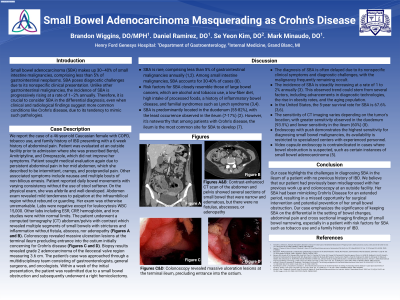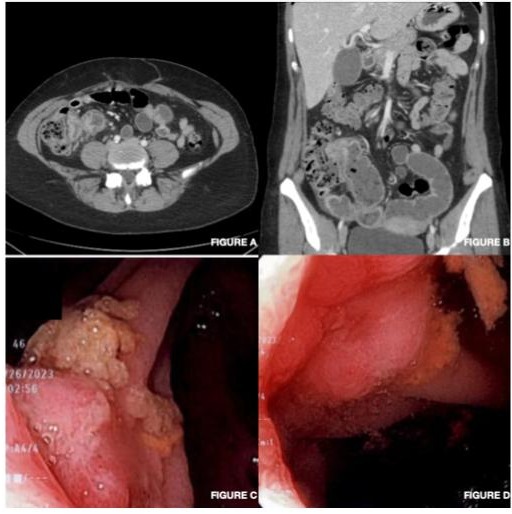Monday Poster Session
Category: Small Intestine
P3300 - Small Bowel Adenocarcinoma Masquerading as Crohn’s Disease
Monday, October 28, 2024
10:30 AM - 4:00 PM ET
Location: Exhibit Hall E

Has Audio

Se Yeon Kim, DO
Ascension Genesys
grand blanc, MI
Presenting Author(s)
Brandon T. Wiggins, DO, MPH1, Daniel Ramirez, DO2, Se Yeon Kim, DO2, Mark Minaudo, DO2
1Ascension Genesys Hospital, Grand Blanc, MI; 2Ascension Genesys, Grand Blanc, MI
Introduction: Small bowel adenocarcinoma (SBA) makes up 30–40% of small intestine malignancies, comprising less than 5% of gastrointestinal neoplasms. SBA poses diagnostic challenges due to its nonspecific clinical presentation. Unlike other gastrointestinal malignancies, the incidence of SBA is progressively rising at a rate of 1–2% annually. Therefore, it is crucial to consider SBA in the differential diagnosis, even when clinical and radiological findings suggest more common conditions like Crohn's disease, due to its tendency to mimic such pathologies.
Case Description/Methods: A 46-year-old Caucasian female with COPD, tobacco use, and a family history of IBD presented with a 6-week history of abdominal pain. Prior to admission, an outside facility evaluated the patient and diagnosed her with IBS. Patient sought medical evaluation again because of persistent abdominal pain in her mid-abdomen, which she described as intermittent, crampy, and postprandial. On physical exam, she was afebrile and well-developed. Abdomen was mildly tender to palpation in the infraumbilical region without rebound or guarding. Labs revealed leukocytosis. Patient underwent a CT abdomen/pelvis with contrast which revealed multiple segments of small bowels with strictures and inflammation without fistula, abscess, or adenopathy. Colonoscopy revealed massive ulceration at the terminal ileum precluding entrance into the ostium, initially concerning for Crohn's disease. Biopsy results revealed grade 2 adenocarcinoma of the ileocecal valve region measuring 3.6 cm. Within a week of the initial presentation, the patient was readmitted due to a small bowel obstruction and subsequently underwent a right hemicolectomy.
Discussion: Our case highlights difficulties in diagnosing SBA due to its rarity. We suspect an incorrect diagnosis of our patient occurred during the prior workup and colonoscopy at an outside facility. Her SBA had been mimicking Crohn's disease for an extended period, resulting in a missed opportunity for surgical intervention and potential prevention of her small bowel obstruction. Our case emphasizes the importance of considering SBA in the presence of bowel changes, persistent abdominal pain, and image findings of small bowel narrowing, especially in a patient population with risk factors for SBA such as tobacco use and a family history of IBD.

Disclosures:
Brandon T. Wiggins, DO, MPH1, Daniel Ramirez, DO2, Se Yeon Kim, DO2, Mark Minaudo, DO2. P3300 - Small Bowel Adenocarcinoma Masquerading as Crohn’s Disease, ACG 2024 Annual Scientific Meeting Abstracts. Philadelphia, PA: American College of Gastroenterology.
1Ascension Genesys Hospital, Grand Blanc, MI; 2Ascension Genesys, Grand Blanc, MI
Introduction: Small bowel adenocarcinoma (SBA) makes up 30–40% of small intestine malignancies, comprising less than 5% of gastrointestinal neoplasms. SBA poses diagnostic challenges due to its nonspecific clinical presentation. Unlike other gastrointestinal malignancies, the incidence of SBA is progressively rising at a rate of 1–2% annually. Therefore, it is crucial to consider SBA in the differential diagnosis, even when clinical and radiological findings suggest more common conditions like Crohn's disease, due to its tendency to mimic such pathologies.
Case Description/Methods: A 46-year-old Caucasian female with COPD, tobacco use, and a family history of IBD presented with a 6-week history of abdominal pain. Prior to admission, an outside facility evaluated the patient and diagnosed her with IBS. Patient sought medical evaluation again because of persistent abdominal pain in her mid-abdomen, which she described as intermittent, crampy, and postprandial. On physical exam, she was afebrile and well-developed. Abdomen was mildly tender to palpation in the infraumbilical region without rebound or guarding. Labs revealed leukocytosis. Patient underwent a CT abdomen/pelvis with contrast which revealed multiple segments of small bowels with strictures and inflammation without fistula, abscess, or adenopathy. Colonoscopy revealed massive ulceration at the terminal ileum precluding entrance into the ostium, initially concerning for Crohn's disease. Biopsy results revealed grade 2 adenocarcinoma of the ileocecal valve region measuring 3.6 cm. Within a week of the initial presentation, the patient was readmitted due to a small bowel obstruction and subsequently underwent a right hemicolectomy.
Discussion: Our case highlights difficulties in diagnosing SBA due to its rarity. We suspect an incorrect diagnosis of our patient occurred during the prior workup and colonoscopy at an outside facility. Her SBA had been mimicking Crohn's disease for an extended period, resulting in a missed opportunity for surgical intervention and potential prevention of her small bowel obstruction. Our case emphasizes the importance of considering SBA in the presence of bowel changes, persistent abdominal pain, and image findings of small bowel narrowing, especially in a patient population with risk factors for SBA such as tobacco use and a family history of IBD.

Figure: A contrast-enhanced CT scan of the abdomen and pelvis showed several sections of small bowel that were narrow and edematous, but there were no fistulas, abscesses, or adenopathy (Figures A and B). Colonoscopy revealed massive ulceration at the terminal ileum, precluding entrance into the ostium (Figures C and D).
Disclosures:
Brandon Wiggins indicated no relevant financial relationships.
Daniel Ramirez indicated no relevant financial relationships.
Se Yeon Kim indicated no relevant financial relationships.
Mark Minaudo indicated no relevant financial relationships.
Brandon T. Wiggins, DO, MPH1, Daniel Ramirez, DO2, Se Yeon Kim, DO2, Mark Minaudo, DO2. P3300 - Small Bowel Adenocarcinoma Masquerading as Crohn’s Disease, ACG 2024 Annual Scientific Meeting Abstracts. Philadelphia, PA: American College of Gastroenterology.

